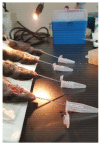Murine Salivary Functional Assessment via Pilocarpine Stimulation Following Fractionated Radiation
- PMID: 29781993
- PMCID: PMC5999332
- DOI: 10.3791/57522
Murine Salivary Functional Assessment via Pilocarpine Stimulation Following Fractionated Radiation
Abstract
Hyposalivation is commonly observed in the autoimmune reaction of Sjögren's syndrome or following radiation injury to the major salivary glands. In these cases, questions remain regarding disease pathogenesis and effective interventions. An optimized technique that allows functional assessment of the salivary glands is invaluable for investigating exocrine gland biology, dysfunction, and therapeutics. Here, we present a step by step approach to performing pilocarpine stimulated saliva secretion, including tracheostomy and the dissection of the three major murine salivary glands. We also detail the appropriate murine head and neck anatomy accessed during these techniques. This approach is scalable, allowing for multiple mice to be processed simultaneously, thus improving the efficiency of the work flow. We aim to improve the reproducibility of these methods, each of which has further applications within the field. In addition to saliva collection, we discuss metrics for quantifying and normalizing functional capacity of these tissues. Representative data are included from submandibular glands with depressed salivary gland function 2 weeks following fractionated radiation (4 doses of 6.85 Gy).
References
-
- Bradley P, O'Hara J. Diseases of the salivary glands. Surgery (Oxford) 2015;33(12):614–619.
-
- Fox PC. Salivary enhancement therapies. Caries Research. 2004;38(3):241–246. - PubMed
-
- Konings AWT, Coppes RP, Vissink A. On the mechanism of salivary gland radiosensitivity. International Journal of Radiation Oncology Biology Physics. 2005;62(4):1187–1194. - PubMed
-
- Burlage FR, Coppes RP, Meertens H, Stokman MA, Vissink A. Parotid and submandibular/sublingual salivary flow during high dose radiotherapy. Radiotherapy and Oncology. 2001;61(3):271–274. - PubMed
Publication types
MeSH terms
Substances
Grants and funding
LinkOut - more resources
Full Text Sources
Other Literature Sources
Medical







